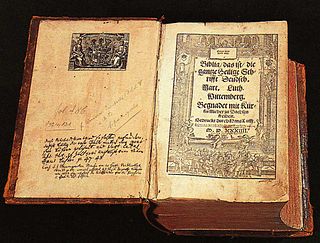 W
WThe 1614 Low German Bible is a rare, illustrated folio edition in Low German of Martin Luther's High German translation of the Bible. Illustrations in the bible are woodcuts from the Hans Stern publishing family in early Lüneburg, Germany.
 W
WThe Berleburg Bible is a German translation of the Bible with copious commentary in eight volumes, compiled in Bad Berleburg during 1726–1742. It is an original translation from the Hebrew and Greek, along with the Piscator-Bibel (1602–1604) among the first German translations independent of Luther's Bible.
 W
WThe Calov Bible is a three-volume 17th-century Bible that contains German translations and commentary by Martin Luther and additional commentary by Wittenberg theology professor Abraham Calovius.
 W
WThe Darby Bible refers to the Bible as translated from Hebrew and Greek by John Nelson Darby.
 W
WThe Luther Bible is a German language Bible translation from Hebrew and ancient Greek by Martin Luther. The New Testament was first published in 1522 and the complete Bible, containing the Old and New Testaments with Apocrypha, in 1534. It was the first full translation of the Bible into German based mainly on the original Hebrew and Greek texts and not the Latin Vulgate translation.
 W
WThe New World Translation of the Holy Scriptures (NWT) is a translation of the Bible published by the Watch Tower Bible and Tract Society. The New Testament portion was released in 1950, as The New World Translation of the Christian Greek Scriptures, with the complete Bible released in 1961; it is used and distributed by Jehovah's Witnesses. Though it is not the first Bible to be published by the group, it is their first original translation of ancient Classical Hebrew, Koine Greek, and Old Aramaic biblical texts. As of September 2020, the Watch Tower Society has published more than 220 million copies of the New World Translation in whole or in part in 193 languages. Though commentators have said a scholarly effort went into the translation, critics have described it as biased.
 W
WThe Racovian New Testament refers to two separate translations produced by the Unitarian Polish Brethren at the printing presses of the Racovian Academy, Raków, Poland.
 W
WThe Schlachter-Bibel is a German translation of the Bible by Franz Eugen Schlachter, first translated from the Greek and Hebrew text of the Bible in 1905. Schlachter was a preacher of the Evangelische Gesellschaft in Bern, Switzerland influenced by the holiness movement.
 W
WThe Wenceslas Bible or the Bible of Wenceslaus IV is a multi-volume illuminated biblical manuscript written in the German language. The manuscript was commissioned by the King Wenceslaus IV of Bohemia and made in Prague in the 1390s. The Wenceslas Bible is unique and very precious not only because of its text, which is one of the earliest German translations of the Bible, but also because of its splendid illuminations. This oldest German deluxe Bible manuscript remained uncompleted.
 W
WThe Zürich Bible is a Bible translation historically based on the translation by Huldrych Zwingli. Recent editions have the stated aim of maximal philological exactitude.